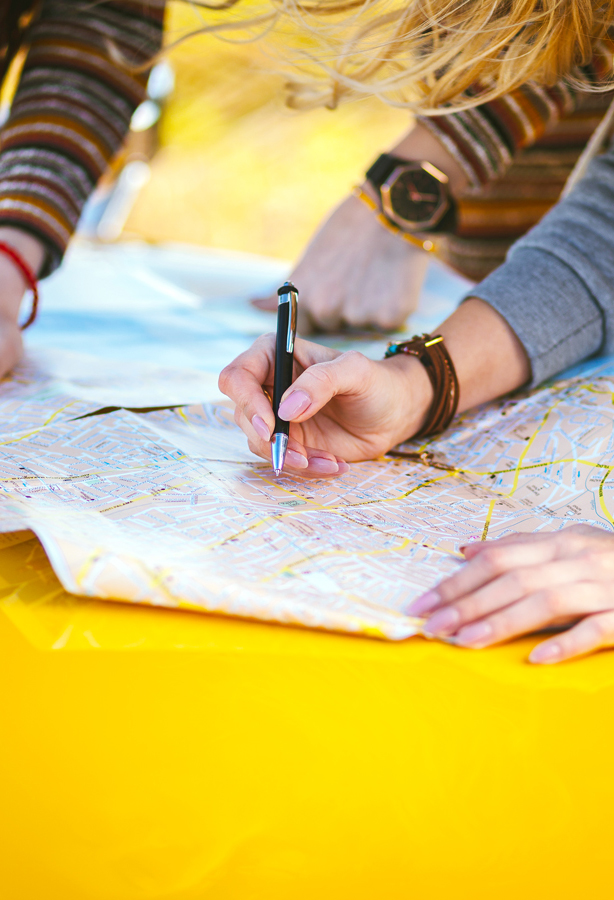There are few travel experiences more liberating than hopping in the car and hitting the open road. But as adventurous as road trips may be, they come with their own risks that are different from what you may encounter while traveling by boat, train, or plane. Whether you’re embarking on a cross-country adventure or simply heading a few hours away, it’s important to take extra caution on these journeys. Here are seven essential road trip safety tips that could end up saving your life.
Pack the Right Items in an Emergency Kit

According to a survey from Liberty Mutual, nearly half of Americans planning road trips don’t check their cars for emergency items before departing. But there’s always a chance you’ll run into a tricky situation — perhaps a flat tire or a dead battery — where you may find yourself stranded on the side of the road. In these cases, help may be hours away, which is why packing an emergency survival kit is an absolute necessity for any road trip.
There’s no one correct way to pack these kits, but you’ll want to think about hydration, sustenance, first aid materials, and tools that can help get your car back on the road. This includes equipment such as tire gauges, air pumps, road flares, jumper cables, cell phone chargers, a flashlight, and windshield de-icing fluid — basically anything that might be useful in an emergency that you can conceivably toss in the trunk in a backpack or crate you already have at home. And if you’re planning on traveling in a particularly remote area of the country, then it may also be worth investing in a radio communication device that allows you to contact others if there’s no cell service.
For sustenance, you should pack enough bottled water to last you and everyone else in the car in case you’re stranded for several hours or days. It’s also worth bringing non-perishable food like granola bars and other snacks packed with energizing protein. Keep in mind that temperatures can also dip overnight, so consider adding several wool blankets to stay warm. Last but not least, pack everyday first aid supplies such as band-aids, medications, and antiseptic lotion.
Have Your Vehicle Inspected Well Before You Depart

Road trippers also often forget to check how long it’s been since their vehicle had a tune-up. If it’s been months — or even years — since your vehicle was last inspected by a professional, then it’s crucial to make an appointment to get the car checked — before hitting the road. Even if your car handles your normal daily driving, it may not keep up with the demands of a weeks-long road trip.
It’s important to have a technician check components such as the battery, brakes, and (especially) tires to ensure that they’ve still got plenty of traction. Don’t assume that the car is good to go until a trained mechanic signs off on the vehicle. You might also want to learn a few basic maintenance skills yourself (if you don’t know them already) — things like checking tire pressure and adding windshield wiper fluid. And consider signing up for a service like AAA if you’re not already a member, which can provide you with roadside aid in the event that things go awry.
Abide by the Nine-Hour Rule

One of the biggest perils that travelers encounter on road trips is trying to push their bodies too far. In some circumstances, drowsy driving can be similar to drunk driving — studies have shown that 24 hours without sleep equates to a blood alcohol content of 0.10%, which would be higher than the legal limit. A good rule of thumb is to cap your drives at a maximum of nine hours per day, taking 30 to 45-minute breaks on occasion in order to stretch your legs. Pushing yourself past nine hours puts you and all the other passengers in the vehicle at risk, so plan your hotel stays accordingly.
Add Saved Places to Your Itinerary Beforehand

Hitting the open road without a plan may seem idyllic to some, but it’s far from the most practical way to go about your road trip. Allow yourself enough time to research all of the nearby attractions you might want to see, adding them to your saved places in Google Maps or your GPS. Crucially, make sure your navigation device is easy to reach or, better yet, plugged into your car’s bluetooth system so you don’t get distracted on the road.
You can always add in a new stop along the way, but it’s helpful to have an idea of what you might want to see — and how long visiting each attraction will take — so you can reach your stopping point safely each night. Knowing where you’re going can also save you money, allowing you to book hotels in advance that are within your budget. If you don’t figure out where you’re staying beforehand, you may end up paying a premium for an overpriced roadside hotel that may be your only option in the area.
Fill Up on Gas While You Can

Breaking down on the side of the road with an empty gas tank is a peril that far too many drivers unexpectedly encounter, and it’s one that’s easily avoidable. If you’re a city dweller, you might take for granted having a 24-hour gas station every few miles. But in less populated stretches of the country like the Southwest or Great Plains, there are isolated stretches of road where you can travel for over 100 miles before hitting a gas station. Even when you get to that gas station, it may be closed down for the night. So, stock up on gas while you still can, even if your tank is nowhere near empty.
Check the Weather Report Every Morning

Extreme weather conditions can not only pose incredible danger to drivers, but they also may add hours of delays to any road trip. You’ll probably check the forecast when planning and packing for your road trip, but it’s easy to forget to do so when you wake up each morning on the road.
Look at the forecast of the areas that you’ll be traveling through — if you notice heavy rains or blizzard conditions, you have a few available options. One is to plan a different route, which may actually end up saving you time. Another option is to stay where you are until the weather improves, even if that means switching around some hotel reservations. Whatever you do, don’t try to travel through hazardous conditions, especially in areas of the country that you’re unfamiliar with.
Be Mindful of Local Driving Laws

While driving laws are largely the same no matter where you are in the United States, certain states have regulations that you may not be familiar with. For example, while most of the country mandates hands-free cell phone use while driving, places like Alabama and Mississippi have no such law. Even if this doesn’t affect you, it’s worth keeping an eye on the road for other distracted drivers who may be preoccupied using their phones. Other states also have rules and regulations about changing lanes, turning right on red, and rules about driving with a crack in your windshield. Do a little online research about the laws in each state you’ll be visiting so that you’re not caught flat-footed when it’s too late.
More from our network
Daily Passport is part of Optimism, which publishes content that uplifts, informs, and inspires.























